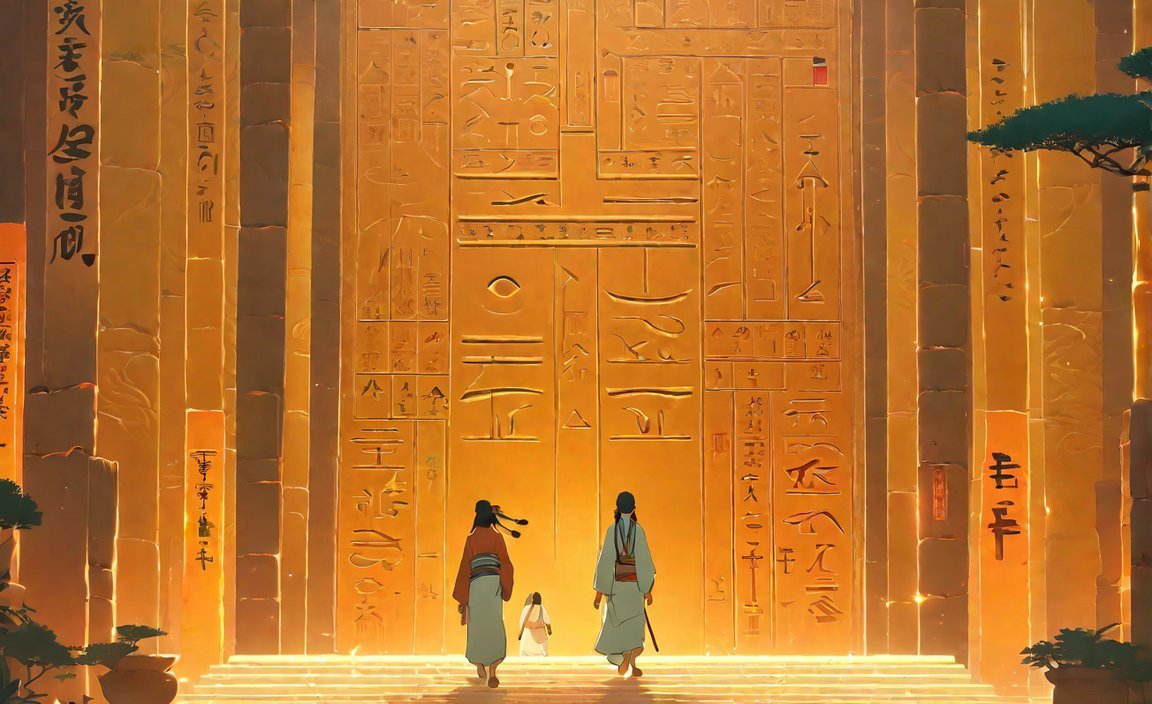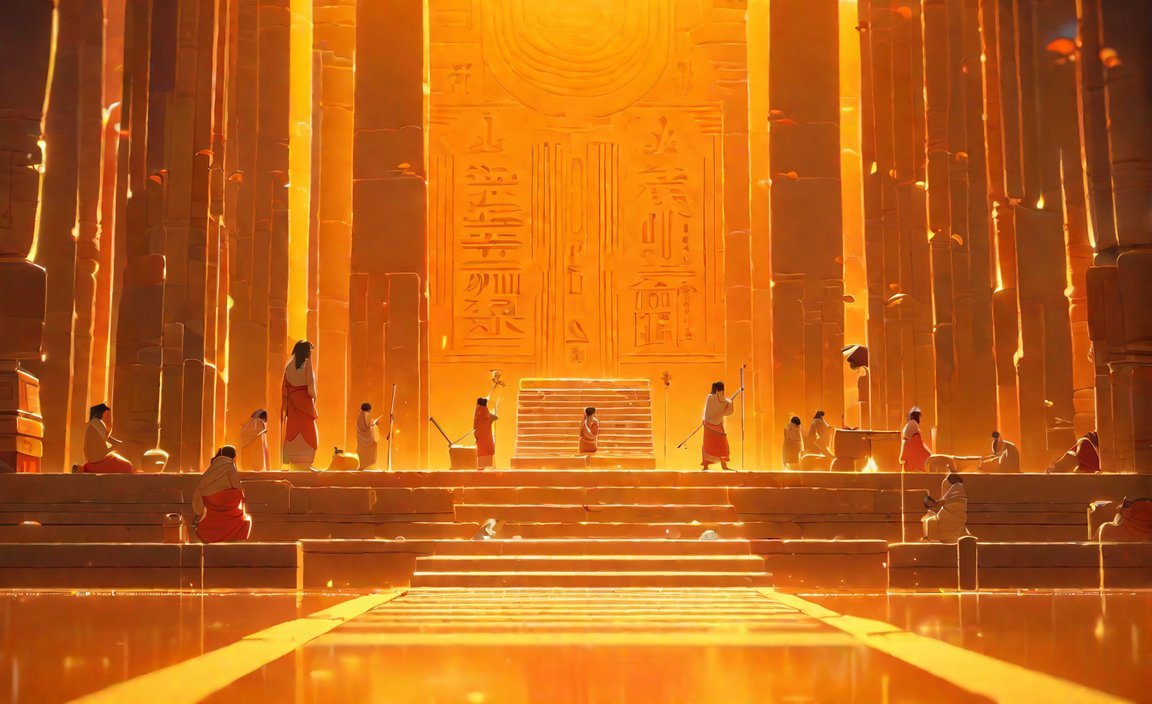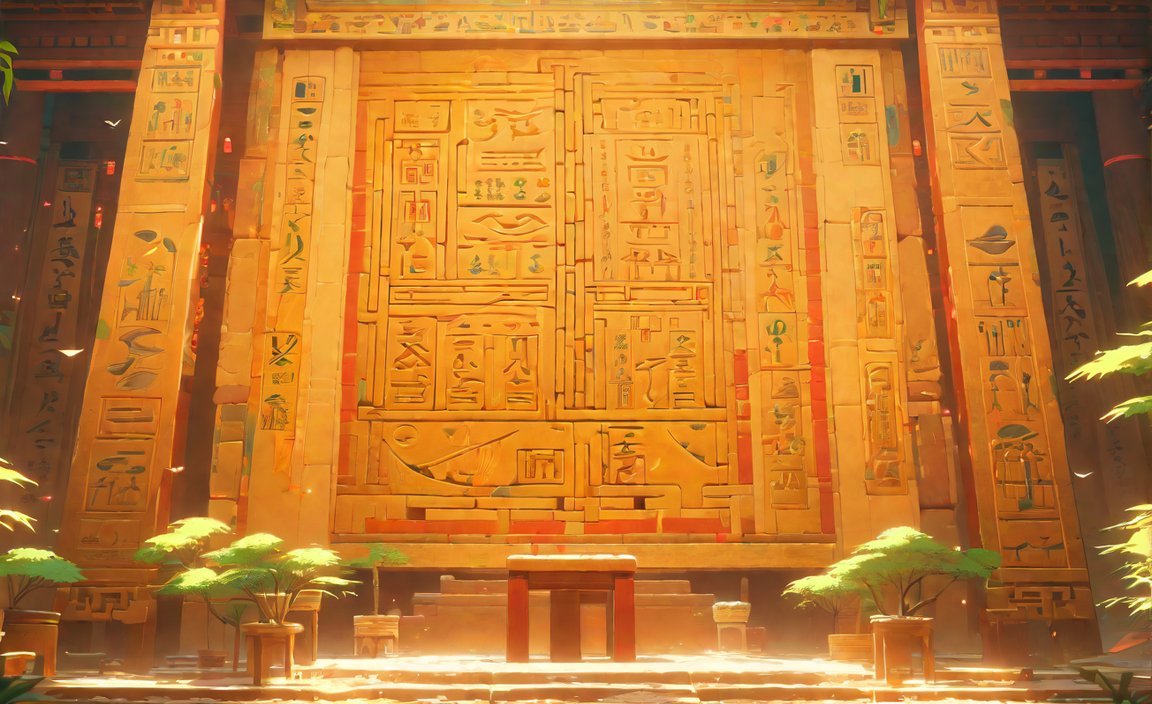Unlocking the mysteries of the past, hieroglyphics offer a mesmerizing glimpse into the ancient world of Egypt. These intricate and enigmatic symbols have fascinated historians, linguists, and archaeologists for centuries. As we delve into the captivating realm of hieroglyphics, prepare to be amazed by the wealth of knowledge hidden within these ancient texts. From their origins and evolution to their intricate meanings and decipherment, this article will unravel the secrets surrounding hieroglyphics and shed light on their importance in understanding the rich history of ancient Egypt.
Key Takeaways:
- Hieroglyphs were the formal writing system used in Ancient Egypt, combining logographic, syllabic, and alphabetic elements with around 1,000 distinct characters.
- Cursive hieroglyphs were used for religious literature, while hieroglyphics were also used for record-keeping and monumental displays dedicated to royalty and deities.
- The word “hieroglyph” comes from the Greek words for “sacred” and “carved in stone.”
- The last known hieroglyphic inscription dates back to 394 C.E.
- Other scripts were developed over time for writing Egyptian.
- Hieroglyphics can be found on a variety of ancient Egyptian artifacts, such as seals, plaques, tombs, pottery, and walls, providing insights into beliefs, gods, clothing, everyday life, and culture.
- The ancient Egyptians also used papyrus and writing boards to record laws, taxation, and government business.
Facts about the Hieroglyphics

Hieroglyphics, the ancient Egyptian writing system, hold a treasure trove of fascinating facts that give us insight into the rich history and culture of Ancient Egypt. From their intricate design to their sacred meaning, let’s delve into the captivating world of hieroglyphics.
The Oldest Writing System in the World
Did you know that hieroglyphs were the formal writing system used in Ancient Egypt for writing the Egyptian language? Dating back thousands of years, they are considered the oldest writing system in the world. With over 1,000 distinct characters, hieroglyphs combined logographic, syllabic, and alphabetic elements, creating a complex and versatile system of communication.
Sacred Carvings in Stone
The word “hieroglyph” originates from the Greek words “hieros,” meaning sacred, and “gluptien,” meaning carved in stone. Indeed, hieroglyphs were most commonly found on stone monuments, such as temples and tombs. From monumental displays dedicated to royalty and deities to intricate inscriptions on sacred texts, hieroglyphs adorned the ancient Egyptian landscape, conveying messages of spirituality and power.
Beyond Stone: Cursive Hieroglyphs and Writing Materials
While hieroglyphs are popularly associated with stone carvings, they were not limited to such medium. Cursive hieroglyphs, a simplified script, were used for religious literature written on materials like papyrus and wood. These materials allowed for more flexibility and faster writing, making them ideal for everyday religious texts and personal correspondence.
Decoding Ancient Egyptian Life and Culture
Hieroglyphics provide us with valuable clues about ancient Egyptian life and culture. They are found not only on seals, plaques, and tombs but also on pottery and the walls of ancient Egyptian remains. These intricate symbols tell us stories about the beliefs, gods, clothing, everyday life, and culture of the people who lived thousands of years ago. Through the deciphering of hieroglyphic texts, archaeologists and Egyptologists have been able to uncover the secrets of this ancient civilization.
Evolving Scripts
Hieroglyphics were not the only script used to write Egyptian. Over time, other scripts, such as hieratic (a cursive script) and demotic (a simplified script), were developed. Each script had its own purpose and complexity, catering to different needs in various contexts. While hieroglyphs were reserved for formal and religious texts, hieratic and demotic scripts were preferred for administrative and everyday writings.
The Last Inscription
The journey of hieroglyphics came to a close in the late 4th century C.E. The last known hieroglyphic inscription dates back to 394 C.E., marking the end of a legacy that spanned millennia. However, the ancient secrets contained within these intricate symbols continue to captivate us today.
Papyrus and Writing Boards
In addition to stone carvings, the ancient Egyptians also utilized papyrus and writing boards for everyday writing. Papyrus, a type of paper made from reed fiber, was commonly used to record laws, taxation, and government business. Writing boards, known as ostraca, were made from pieces of broken pottery or limestone flakes, providing a portable and reusable writing surface for quick notes and calculations.
So, the next time you marvel at the hieroglyphic inscriptions on ancient Egyptian remains, remember that these symbols carry within them a wealth of knowledge about a civilization that thrived thousands of years ago. Through hieroglyphics, we can decipher their stories and unravel the mysteries of Ancient Egypt.
Sources:
[^1^]: Khan Academy – Ancient Egyptian hieroglyphs overview
[^2^]: BBC Bitesize – What were ancient Egyptian hieroglyphs?
Here are some interesting facts about Albania. Discover more at Facts about Albania.
Check out these intriguing facts on Chess! Find out more at Facts on Chess.
Explore the wonders of the Sonoran Desert with these fascinating facts. Visit Facts about Sonoran Desert to learn more.
Experience the beauty of Central Park through these captivating facts. Uncover more at Facts Central Park.
Learn about the historical Temple of Artemis with these intriguing facts. Delve into Facts about Temple of Artemis for more information.
Discover the diverse and fascinating country of Uganda with these interesting facts. Get the scoop at Facts about Uganda.
Interested in real estate? Check out these enlightening facts about the market at Facts about real estate.
Escape to the beach with these fascinating facts about sandy shores and ocean waves. Dive into Facts about the beach for more details.
The Complexity and Symbolism of Hieroglyphics
Hieroglyphics, the ancient Egyptian writing system, have captivated scholars and historians for centuries. These intricate symbols, found on various objects, provide valuable insights into the beliefs, culture, and everyday life of ancient Egypt[^4^]. Let’s delve into the fascinating complexity and symbolism of hieroglyphics.
The Sacred Carvings
The term “hieroglyph” originates from the Greek translation of the Egyptian phrase “the god’s words,” emphasizing the sacred nature of these carvings[^2^]. In fact, ancient scholars like Herodotus referred to hieroglyphics as ‘holy writing’ and believed they possessed divine qualities[^1^].
A Multifaceted Script
Hieroglyphics primarily represent sounds or groups of sounds, but they can also depict objects. This multifaceted script played a significant role in monumental contexts, particularly in identifying royal individuals or specific events like hunts or battles[^5^]. Deciphering hieroglyphics was not an easy task and it was only in the early 19th century that scholars unveiled its logographic, syllabic, and alphabetic elements[^7^].
Complexity and Exclusivity
The complexity of hieroglyphics is evident in the fact that only a select few Egyptians, mostly priests, had the ability to read and understand this intricate script[^8^]. With thousands of different symbols and no spaces between words or punctuation marks, deciphering hieroglyphics required exceptional skill and knowledge[^10^].
Hieratic and Demotic Scripts
While hieroglyphics were the formal writing system, ancient Egyptians also developed hieratic writing and demotic writing for different purposes. Hieratic writing was a cursive script used for religious literature, written on materials like papyrus and wood. On the other hand, demotic writing was a simplified form of hieratic that provided greater convenience and accessibility[^9^].
Unlocking Ancient Secrets
Exploring the ancient beauty of Egyptian hieroglyphics allows us to unlock the secrets and stories of ancient Egypt, preserving their legacy for future generations[^3^]. These sacred carvings offer a window into the rich history and culture of one of the world’s most fascinating civilizations.
Key Takeaways:
– Hieroglyphics were considered sacred and were referred to as ‘holy writing’.
– The script represented sounds or groups of sounds, with the ability to depict objects.
– Deciphering hieroglyphics was a monumental task that involved understanding its logographic, syllabic, and alphabetic elements.
– Only a select few Egyptians, primarily priests, could read hieroglyphic writing, underscoring its complexity and exclusivity.
– Hieratic and demotic scripts were alternative forms of writing developed for different purposes in ancient Egypt.
Citations:
– World History Encyclopedia: Egyptian Hieroglyphs
– Britannica: Hieroglyph
Methods and Tools used for Hieroglyphic Translation
When it comes to deciphering the ancient Egyptian script of hieroglyphics, researchers and experts have employed various methods and tools to unlock its secrets. In this article, we will explore the fascinating techniques used to translate hieroglyphic texts and uncover the mysteries of ancient Egypt. So, let’s dive right in!
Methods of Hieroglyphic Translation
- Deep Learning Techniques: In recent years, researchers have harnessed the power of deep learning techniques to assist in hieroglyphic translation. One notable study utilized a dedicated Convolutional Neural Network (CNN) known as Glyphnet. This CNN, trained on hieroglyph datasets, provided promising results in the automated decipherment of hieroglyphic inscriptions. Other deep learning models like EfficientNet, MobileNet, and ShuffleNet have also been tested for hieroglyphic translation, showcasing the potential of artificial intelligence in this field.
- Paper and Pencil Tracing: Before the advent of digital technology, archeologists and Egyptologists relied on the meticulous method of paper and pencil tracing to decipher hieroglyphic inscriptions. By carefully tracing the contours and shapes of the hieroglyphs onto paper, researchers could analyze the symbols and compare them to known translations and patterns. This method required immense skill and attention to detail.
- Large-Format Photography: Another technique employed by researchers is the use of large-format photography to capture hieroglyphic inscriptions in high resolution. This allows for a detailed examination of the intricate symbols and facilitates a more accurate translation. By zooming in on specific portions of the inscription, experts can focus on individual hieroglyphs and analyze their context within the larger text.
Tools for Hieroglyphic Translation
- Fabricius by Google’s Arts & Culture: Google’s Arts & Culture app features a powerful tool called Fabricius, which utilizes machine learning to decode hieroglyphics. This AI-powered translator can not only translate users’ own words and emojis into hieroglyphs but also provide translations of ancient Egyptian texts. As more people use Fabricius, its machine learning algorithms improve, further enhancing the accuracy of hieroglyphic translation.
- The Rosetta Stone: One of the most famous tools used for deciphering hieroglyphics is the Rosetta Stone. This ancient artifact, discovered in 1799, contains a decree issued in 196 BCE by King Ptolemy V in three scripts: hieroglyphics, demotic script, and Greek. The discovery of the Rosetta Stone allowed scholars to compare the hieroglyphic text with the known Greek translation, paving the way for the unraveling of the hieroglyphic script.
Key Takeaways:
- Deep learning techniques, such as Convolutional Neural Networks (CNN), have been utilized for hieroglyphic translation, showing promising results.
- Traditional methods like paper and pencil tracing and large-format photography are still valuable for analyzing hieroglyphic inscriptions.
- Google’s Arts & Culture app offers an AI-powered hieroglyphics translator called Fabricius, enabling users to translate their own words and emojis into hieroglyphs.
- The Rosetta Stone played a pivotal role in the decipherment of hieroglyphics, providing a parallel translation in Greek and demotic script.
Modern Understanding and Preservation of Hieroglyphics
Hieroglyphics, the ancient Egyptian form of pictorial writing, have captivated archaeologists and scholars for centuries. As an experienced archaeologist specializing in ancient Egyptian history and hieroglyphics, I have dedicated years to deciphering and understanding these intricate symbols. In this article, I will unveil fascinating facts about hieroglyphics and discuss their modern understanding and preservation.
The Mysterious Language of Hieroglyphics
Hieroglyphic symbols served as a means of communication and recording information on ancient Egyptian monuments. These symbols could represent objects, sounds, or even groups of sounds in the ancient Egyptian language. The word “hieroglyphics” itself is derived from Greek, with “hiero” meaning “holy” and “glyphics” meaning “marks” or “writings.” However, deciphering hieroglyphic writing was not an easy task, and only a select few Egyptians, mostly priests, possessed the necessary knowledge.
Decoding the Secrets: Rosetta Stone and Beyond
The study of hieroglyphics took a major leap forward with the discovery of the Rosetta Stone in 1799. This artifact played a crucial role in deciphering hieroglyphic writing by providing a parallel translation in Greek and demotic script. The Rosetta Stone offered a key to unlocking the meaning behind these ancient symbols and enabled scholars to make significant progress in their understanding. Since then, continued archaeological discoveries and the study of ancient Egyptian texts have contributed to modern understanding and preservation efforts.
Hieroglyphics: More than Just Pictures
Contrary to popular belief, hieroglyphic writing is not solely composed of pictorial representations. While some symbols do depict objects, many others represent sounds, similar to the characters in the Roman alphabet. This complexity adds another layer to the fascination surrounding hieroglyphics. Ancient Egyptians also utilized other forms of writing, such as hieratic and demotic scripts, for different purposes.
Preserving Ancient Egypt’s Legacy
Today, the preservation of hieroglyphics involves not only the study of the ancient Egyptian language but also a broader focus on the content and context of ancient Egyptian texts. Institutions like the British Museum have played a significant role in uncovering the secrets of ancient Egypt, including hieroglyphics. Essential archaeological discoveries continue to provide invaluable insights into ancient Egyptian culture and history.
Hieroglyphics in the Modern World
While ancient, hieroglyphics maintain a connection to the modern world. They have been etched into various modern forms, such as barcodes, demonstrating their continued relevance. Furthermore, advancements in technology have allowed for the development of AI-powered hieroglyphic translators, enabling enthusiasts to engage with this ancient script in new ways. Google’s Arts & Culture app features one such translator called Fabricius, which can convert users’ words and emojis into hieroglyphs while providing translations of ancient Egyptian texts.
Key Takeaways:
- Hieroglyphics were a form of pictorial writing used in ancient Egypt to represent objects, sounds, and groups of sounds in the ancient Egyptian language.
- The decipherment of hieroglyphics was made possible through the discovery of the Rosetta Stone, which provided a parallel translation in Greek and demotic script.
- The study of hieroglyphics includes the broader examination and preservation of ancient Egyptian texts and their cultural context.
- Institutions like the British Museum have played a significant role in unraveling the secrets of hieroglyphics and shedding light on ancient Egyptian culture and history.
- Hieroglyphics remain relevant in the modern world, with their symbols being incorporated into various forms, and technological advancements allowing for new ways of engaging with this ancient script.
Sources:
– Encyclopedia Britannica: Hieroglyph
– National Geographic Kids: Facts about Hieroglyphics

FAQ
Q1: What was the purpose of hieroglyphics in ancient Egypt?
A1: Hieroglyphics were used for record-keeping, as well as for monumental display dedicated to royalty and deities.
Q2: How many distinct characters are there in the hieroglyphic writing system?
A2: There are approximately 1,000 distinct characters in the hieroglyphic writing system.
Q3: Were hieroglyphics only used for writing on stone?
A3: No, cursive hieroglyphs were also used for religious literature on materials such as papyrus and wood.
Q4: When was the last known hieroglyphic inscription made?
A4: The last known hieroglyphic inscription was made in 394 C.E.
Q5: Besides hieroglyphics, what other scripts were used to write Egyptian?
A5: Over time, other scripts such as hieratic and demotic writing were developed for different purposes in ancient Egypt.
- Sept 31 Myth: Unveiling Calendar Secrets - March 18, 2025
- How Long & Till December 18, 2025: Accurate Countdown Guide - March 18, 2025
- Discover Japanese Artists: A Complete History - March 18, 2025
















